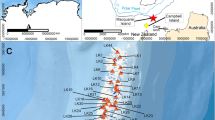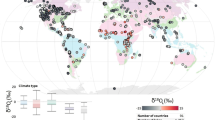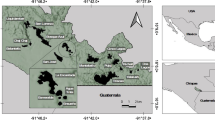Abstract
Conductivity and major ion chemistry data were analyzed for a suite of Nebraska (USA) natural lakes, reservoirs, sand pits, and barrow pits to evaluate the magnitude of climatic versus non-climatic influence on ionic concentration and composition. In both natural lakes and sand and barrow pits, conductivity is positively related to longitude and reflects decreasing effective moisture from east to west. Reservoirs showed no relationship between lake conductivity and location, probably because the reservoirs are very strongly influenced by groundwater and surface water inflow and have shorter residence times relative to the other lake types. At smaller spatial scales, conductivity among natural lakes is variable. Lakes that are at low elevation within a groundwater flow system were fresh, because of substantial input of fresh groundwater. In contrast, lakes at high elevation exhibited a wide range of conductivity, probably because of differences in the degree of connection to groundwater and surface to volume ratio impacts on evaporation rates. Differences also were evident among natural lakes in terms of their response to seasonal changes in precipitation. Sub-saline and saline lakes showed more seasonal variation in conductivity than freshwater lakes, and lakes in the more arid part of the state showed larger responses to precipitation change than those in areas to the east that receive higher precipitation.








Similar content being viewed by others
References
Bleed, A. & C. Flowerday, 1998. An Atlas of the Sand Hills. Conservation and Survey Division, Institute of Agriculture and Natural Resources, University of Nebraska-Lincoln.
Cheng, X. & M. P. Anderson, 1994. Simulating the influence of lake position on groundwater. Water Resources Research 30: 2041–2049.
Eugster, H. P. & B. F. Jones, 1979. The behavior of major solutes during closed-basin brine evolution. American Journal of Science 279: 609–631.
Fritz, S. C. & J. E. Saros, 2005. Paleolimnology and paleohydrology. In Anderson, M. G. (ed.), Encyclopedia of Hydrological Sciences, Vol 3: Ecological and Hydrological Interactions, Vol 3. John Wiley & Sons, Chichester, 1681–1704.
Fritz, S. C., E. Ito, Z. Yu, K. R. Laird & D. R. Engstrom, 2000. Hydrologic variation in the northern Great Plains during the last two millennia. Quaternary Research 53: 175–184.
Gorham, E., W. E. Dean & J. E. Sanger, 1983. The chemical composition of lakes in the north-central United States. Limnology and Oceanography 28: 287–301.
Gosselin, D. C., 1997. Major-ion chemistry of compositionally diverse lakes, Western Nebraska, U.S.A.: implications for paleoclimatic interpretations. Journal of Paleolimnology 17: 33–49.
Gosselin, D. C., S. Sibray & J. Ayers, 1994. Geochemistry of K-rich alkaline, Western Sandhills, Nebraska, USA. Geochimica et Cosmochimica Acta 58: 1403–1418.
Kratz, T., K. Webster, C. Bowser, J. Magnuson & B. Benson, 1997. The influence of landscape position on lakes in northern Wisconsin. Freshwater Biology 37: 209–217.
LaBaugh, J. W., 1986. Limnological characteristics of selected lakes in the Nebraska Sand Hills and their relation to chemical characteristics of adjacent groundwater. Journal of Hydrology 86: 279–298.
Last, W. M., 1992. Chemical composition of saline and subsaline lakes of the northern Great Plains, Western Canada. International Journal of Salt Lake Research. 1: 47–76.
Loope, D. B., J. P. Swinehart & J. P. Mason, 1995. Dune-dammed paleovalleys of the Nebraska Sand Hills-intrinsic versus climatic controls on the accumulation of the lake marsh sediments. Geological Society of American Bulletin 107: 396–406.
Mason, J. P., J. P. Swinehart & D. Loope, 1997. Holocene history of lacustrine marsh sediments in a dune-blocked drainage, Southwestern Nebraska Sand Hills, USA. The Holocene 14: 209–217.
McCarraher, B. & D. Bruce, 1977. Nebraska’s Sandhills Lakes. In Huff, E. (ed.), Nebraska Game and Parks Commission Publisher, Lincoln, 1–67.
Riffenburg, H. B., 1925. Chemical character of ground waters of the northern Great Plains. U.S. Geological Survey Water Supply Paper 560-B: 31–52.
Schindler, D. W., S. E. Bayley, B. R. Parker, K. G. Beaty, D. R. Cruikshank, E. J. Fee, E. U. Schindler & M. P. Stainton, 1996. The effects of climatic warming on the properties of boreal lakes and streams at the experimental lake area, northwestern Ontario. Limnology and Oceanography 41: 1004–1017.
Telford, R. J. & H. F. Lamb, 1999. Groundwater-mediated response to Holocene climatic change recorded by the diatom stratigraphy of an Ethiopian crater lake. Quaternary Research 52: 63–75.
Webster, K. E., P. A. Soranno, S. B. Baines, T. K. Kratz, C. J. Bowser, P. J. Dillon, P. Campbell, E. J. Fee, & R. E. Hecky, 2000. Structuring features of lake districts: landscape controls on lake chemical responses to drought. Freshwater Biology 43: 499–515.
Wilhite, D. A. & K. G. Hubbard, 1998. Climate. In: Bleed, A. & C. Flowerday (eds), An Atlas of the Sand Hills. Conservation and Survey Division. University of Nebraska, Lincoln, 17–28.
Winter, T. C., 1986. Effect of groundwater recharge on configuration of the water table beneath sand dunes and on seepage lakes in the Sandhills of Nebraska, USA. Journal of Hydrology 86: 221–237.
Zlotnik, V. A., M. Burbach, J. Swinehart, D. Bennett, S. C. Fritz, D. B. Loope & F. Olaguera, 2007. A case study of direct push methods for aquifer characterization in dune-lake environments. Environmental and Engineering Geology, in press.
Acknowledgements
We thank J. Leach, A. Beringer, J. Swinehart, M. Burbach, and Ben Harris for assistance in the field. Supported by grants from the USEPA STAR program and The UNL Water Center (USGS Program 104B).
Author information
Authors and Affiliations
Corresponding author
Rights and permissions
About this article
Cite this article
Bennett, D.M., Fritz, S.C., Holz, J.C. et al. Evaluating climatic and non-climatic influences on ion chemistry in natural and man-made lakes of Nebraska, USA. Hydrobiologia 591, 103–115 (2007). https://doi.org/10.1007/s10750-007-0798-z
Issue Date:
DOI: https://doi.org/10.1007/s10750-007-0798-z




